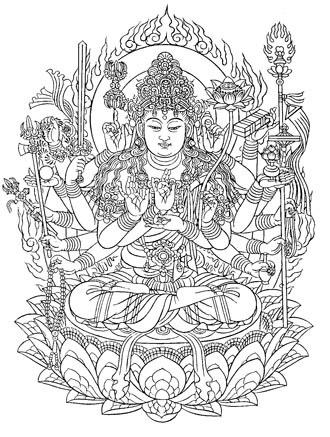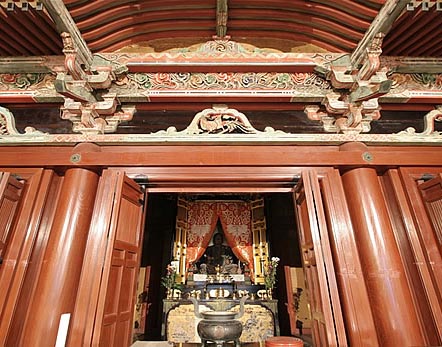
Daigo-ji (醍醐寺), translated as “Daigo Temple,” is a Shingon Buddhist monastery in Fushimi-ku, Kyoto, founded in 874 by the monk Shōbō (posthumously Rigen Daishi). It is a UNESCO World Heritage Site and the head temple of the Daigo branch of the Shingon school. The temple spans two areas: lower Daigo (Shimo-Daigo) with its grand halls and the five-storied pagoda, and upper Daigo (Kami-Daigo) nestled on Mount Daigo, accessible via a steep pilgrimage path.
Honzon – Juntei Kannon (“Mother Kannon”)

The principal image is the secret Juntei Kannon, carved from camphor wood during the Edo period and shown to the public only on May 18 during the annual Gokaihi ritual. It was originally commissioned by Emperor Daigo for the birth of an heir and remains revered as a deity of fertility and safe childbirth.
Things to See at Daigo-ji
- Five-Storied Pagoda – Built in 951, this National Treasure is the oldest wooden building in Kyoto and one of the few structures to survive the Ōnin War.
- Kondō (Golden Hall) – A National Treasure, constructed at Emperor Daigo’s behest and restored under Toyotomi Hideyoshi in 1600.
- Sanbō-in Sub-temple & Gardens – A Momoyama-period Imperial-style villa complex with nationally designated gardens (National Treasure), including the famous Karamon gate.
- Niō-mon Gate, Yakushi-dō, Godai-dō, Nyoirin-dō, and Kaisan-dō – Notable halls and sanctuaries in both lower and upper temple areas, many of which are heritage-listed.
- Reihōkan Museum – Hosts tens of thousands of artifacts, including National Treasures and Important Cultural Properties.
- Kami-Daigo Area (Upper Temple) – A pilgrimage area up Mount Daigo featuring Juntei-dō, Godai Hall, Yakushi Hall, Nyonin-dō (Women's Hall), Shrine of the Pure Dragon (Seiryū-gū Haiden), and the sacred Daigo spring (Daigo-sui).

History of Daigo-ji
Founded in 874 by Rigen Daishi at a sacred spring discovered on Mount Daigo, the temple received imperial patronage from Emperor Daigo and his successors. The early complex included essential halls such as Yakushi-dō (907), Sakyamuni Hall (926), and the five-storied pagoda (951).
Daigo-ji has played a key role in Shingon Buddhism, particularly under the Daigo Minamoto family. Though largely destroyed during the Ōnin and Bunmei wars, the pagoda survived, and restoration efforts by Toyotomi Hideyoshi in the late 16th century revived the temple’s grandeur—he famously held a cherry-blossom viewing party (Daigo no Hanami) here in 1598.
As of today, Daigo-ji remains a major spiritual site with over 75,000 cultural assets, including 18 National Treasures.
Legends of Daigo-ji
Founding by Rigen Daishi
Rigen Daishi (Shōbō) discovered a sacred, sweet spring and had a vision of a five-colored cloud. There, he received instruction from a mountain kami, “Ah, the taste of daigo (ambrosia),” giving rise to the temple’s name. He then enshrined statues of Juntei and Nyoirin Kannon and founded the temple.
Imperial Patronage
Emperor Daigo had no heir; after prayers to Juntei Kannon, twin sons were born. The emperor then patronized the temple—in particular, commissions like Yakushi-dō halls and elevation to an Imperial temple. This is the source of the temple’s honorific designation and imperial legacy.
Daigo no Hanami
In 1598, Toyotomi Hideyoshi hosted a grand cherry blossom party at Sanbō-in, contributing to the temple’s fame and prestige.
Goeika of Daigo-ji
仰くえんも
もらさで救く
願なれば
潅頂堂は
頼もしきかな
“Even with a heavy karma,
if you offer prayers,
the Juntei-dō
becomes a hope-filled sanctuary.”





